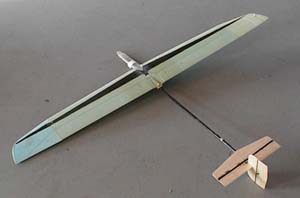
From

To this:
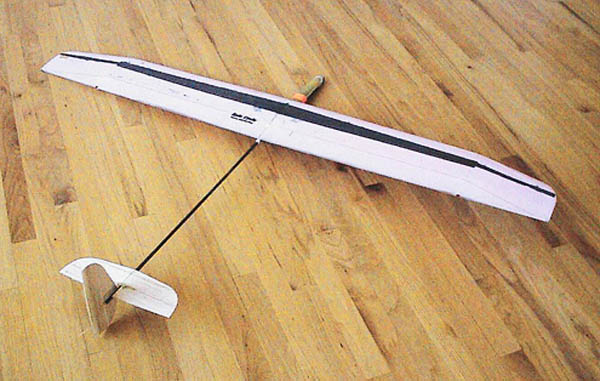
To this:
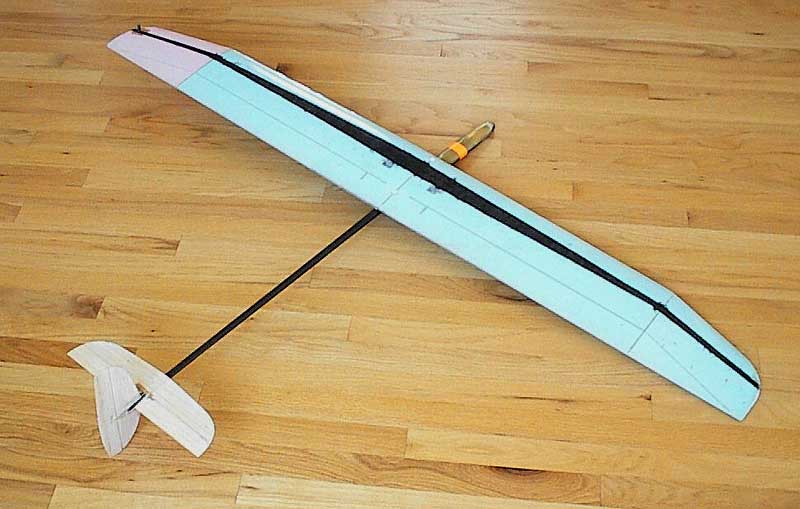
This is my fourth original design HLG. The predecessor to the Spin Cycle was a successful javelin HLG that held it's own against the top commercial designs.
Aileron Version:
Span - 59.0 inches (1.5 m), area 387 sq. in.
Mass - 10.8 oz
Airfoil - The Man-Son-Hing original (WM01), 6.6% thick 1.7% camber transitioning to panel break and tip.
Controls - Flaperons, Rudder, Elevator
Radio - Hitec HS-55's, Hitec 555 receiver, Tadiran 6V (800 mah!)
Pull Pull on elevator and rudder.
Original design pod and pylon, home rolled CF tailboom (Allegro spec)
Alterations associated with the discus style launch
Flat fuselage pod with CF tow to take centrifugal loads. Nobody makes a sideways pod and boom, so mold your own.
X tail - balanced top and bottom to eliminate torque on the boom at speed.
Reduced Dihedral - reduces yaw/roll coupling on launch, but enough for thermal centering.
Large fin/rudder - twice the size needed for a conventional aileron HLG.
Left wing tip reinforcement - allows the plane to be cantilevered by the last 2 inches of the wing.
Continuous upper composite skin - no breaks or joints for extra strength. Let's see the commercial guys start shipping a 59" wing.
CF reinforcement rod across center panel - prevents upper skin buckling.
Trileron - reduces potential for flutter on right wing tip, increased grip area on left wing tip.
Have thrown it for a few hours in the yard, launches quite well but needs elevator preset for launch transition. The hang time is much better than the converted Wizard. Note that the wing has a very low aspect ratio, I figured that it would not reduce launch efficiency since the wing is not lifting during the climb, but would help with the float. We shall see how this plane floats relative to the other HLG's during practice this summer. The cores for this plane were cut on Tuesday, and the plane flew on Sunday evening. This is a record for me, conceptual design to flying in 6 days.
After two days the wing gave up on the launch forces. The upper skin buckled on the left wingtip due to restraining the plane just before release. The plane wants to climb and roll left at the last part of the spin since the outer wingtip is probably doing 100 kph. Holding the plane down for a good launch attitude puts too much stress on the wingtip. Solution? A throwing peg which prevents everything but centrifugal forces on the tip.
The old Wizard comes out again and has a peg put in. 1/8" dia. CF rod, silicone tubing and Kevlar skin patches. Hey this works, now we are throwing even higher. Launch forces are enough to rip the skin from your fingertips.
The next version of the model has a 1/4" diameter throwing peg, and the launches are so fast that I'm surprised that the plane survives at all. Hang time over 1:00, I'll tell you when I get to 2 minutes.. Into the wind and back for 300 meters. Technique on the throw is critical, a wrong move here and the plane will self destruct. I've got the next wing in the vacuum bag already.
Update July, 2001- the analysis by Chis Kaiser indicates that drag on launch is significant due to plane waggle and/or tail drag until the launch attitude stabilizes. On this basis, version 3 has an unbelievably stiff CF boom, 0.60" diameter tapering to 0.375" diameter, 0.016 wall thickness. This boom is stiffer than any commercial 2m fuselages, even the Allegro. Boom stiffness has improved the launch by at least 10 feet, there is no waggle and no rudder preset on launch. After the discussion about gyros, it seems unlikely that a gyro will help this plane at all, plus there is no room in the current pod to fit one. There's a new DLG Encore in the club now, direct comparison of flying and this plane gives up nothing in performance, penetrates better but is more difficult to fly. I'm happy with it and will freeze the design.
Update January, 2002 - After wearing out the latest Spincycle, a new one has been built using the AG04 airfoil. This wing has the more tapered planform of the poly wing and a sharper leading edge. The result is the best of both worlds, sharp stall transition and a slight but noticeable increase in hang time. One definite improvement in flying control is that the AG04 responds to camber changes whereas the WM01 does not. Therefore the speed envelope has improved on the slow end, and looks about the same on the fast end. Mark Drela has also published the Super Gee model with the AG4X series of flapped airfoils. I will try one of those wings on a Spincycle fuselage next.


Bottom view
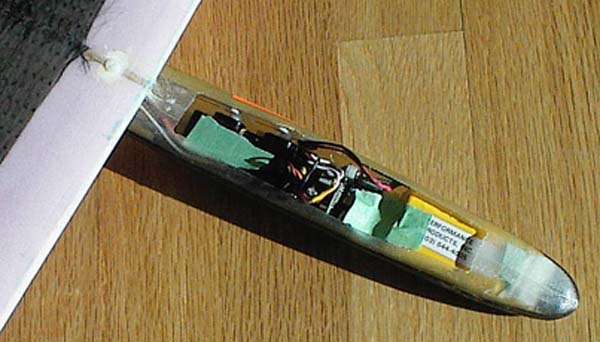
Pod is sideways to take launch loads, servos lie flat. Every wire is cut to length.

Conventional X tail with balanced fin, P/P Spectra lines. Balsa is skinned with 0.75 FG, Kevlar hinge.
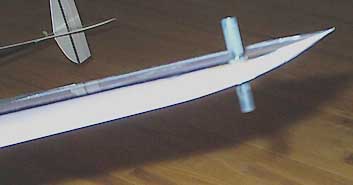
Peg is 1/4" arrowshaft.
I decided that a Polyhedral version (pictured above) would probably float better and give better duration even if the launch height was a little less. So with that in mind, and knowing that the plane would only fly on calmer days, the aileron design was tweaked to be a polyhedral. While the Spin Cycle was primarily designed to launch, this plane is built to fly. Based on my last javelin HLG, the structure has been modified to take the loads.
Final weight is a little heavy at 9.7 ounces, but this version is as strong as the original. The fuselage is from a Raptor Aero Feather XL which I had lying around. The layup on this wing is more robust especially at the joints where the launch forces are rather weird. All kinds of vertical and lateral bracing across the joints should meet the strength requirements. Other changes include the enormously long tail moment and adjustment to the airfoil for the lower wing loading and slower flying speed. Going for a stiff tailboom at 27" long is impossible, so we shall see if the launch height suffers due to the boom flex, so far it looks good. Launch technique is different, the throw is more vertical with a pre-transition in the last 90 degrees of the spin. Very dangerous, a wingtip ground strike is close on every throw.
The first poly plane was lost from a gyro switch failure! After installation of a gyro and remote switch, I flew the plane four or five hours and found that the launches were easier without having to time the preset release, however the max launch height did not improve. Then the switch failed and the the plane augured in after launch with no control. On the bench, the problem was repeatable, turn on radio, hit preset (and activate gyro) then when the gyro was deactivated, no control. Needless to say, I ain't using a gyro anymore. Strange though, switching to a 6V battery eliminates the problem, and everything works.
The second version uses the Apogee airfoil (AG04) with no transition. The planform has bee modified with more taper overall. While the new plane seems to float better, the stall transition of the AG04 is pure mush. The WM01 has a brutal stall break with no mush zone, an a higher max Cl. I prefer the tighter thermalling radius and will give up minimum sink.

Now we are getting somewhere, this is a cross breed airplane between a RE polyhedral floater and an aileron full house. The highly tapered planform is from the typical flaperon plane, this helps to keep the tips lighter too. Slight forward sweep to improve launch, the peg is 1/8" from the wing edge. Short of molding the peg into the wing, this method is the best peg mounting method I've seen. An oversize vertical stab on the stiff 31" boom will give a large amount of yaw damping. Very little poly break, but spirally stable up to a Cl of 0.8. Wing area is 378 in2 to improve the float The V dihedral will improve the straight line L/D but the turning will suffer. The concept is to get to the lift then figure out how to fly in it. Skin is all Kevlar, all up weight is 8.8 ounces for a wing loading of 3.36 oz/ft2. Airfoil is the AG17-18 modified by band saw inaccurate templates. Tail is the HT13 and HT23 modified by wire burns. I've gone back to pushrods on all of my HLG's after getting weary of slack pull/pull lines, P/P are lighter though.
The rate at which I am acquiring (and disposing of) DLG's would make this hobby unaffordable. With reasonable care you can build a better plane than the commercial kits, lighter, no production compromises, and all of the best features of the planes you like. Things like peg placement, airfoil tails, teflon pushrod housings, flap facings and skin hinging can all be done on your planes better than the kits.
Launches on this plane are spectacular for a R/E plane. I'll put the float capability up against any DLG out there. Dead air time greater than 2 minutes? Don't know yet but it's going to be close.
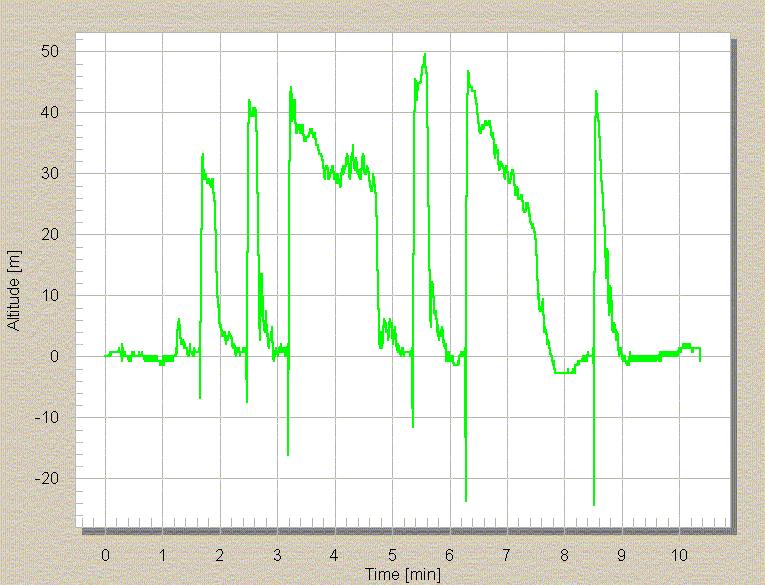
Here is a LoLo trace for a no wind day with the Spincycle. Later in the golf season I am able to throw harder than this and probably get another 2 to3 m at the top. For a 9 oz. polyhedral plane, I think this is pretty good, regularly getting 44 m and should be up to 48 m.
Return to RC Soaring
Copyright W. Man-Son-Hing (2002)